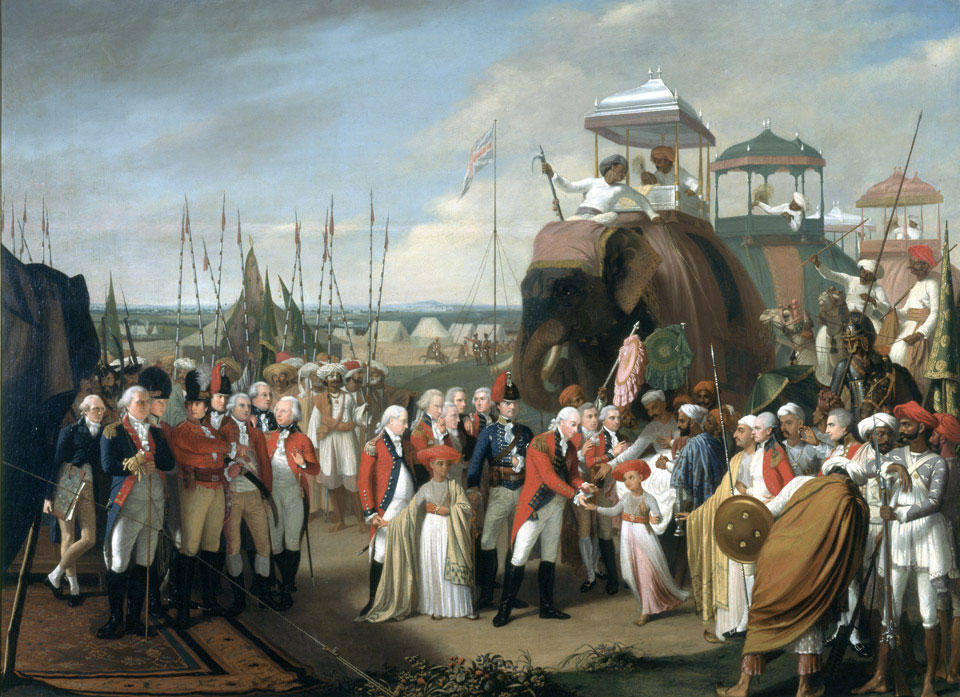
Find the perfect fit with Amazon Prime. Try Before You Buy.
‘The Reception of the Mysorean Hostage Princes by Marquis Cornwallis’
by Robert HomeNational Army Museum in Chelsea, London



‘The Reception of the Mysorean Hostage Princes by Marquis Cornwallis’, 26 February 1792.
Oil on canvas by Robert Home (1752-1834), c.1793.
During the 3rd Mysore War (1790-1792), a British force under Lieutenant-General Lord Cornwallis, Governor-General of India, besieged Tipu Sultan, ruler of Mysore, in his fortified island capital of Seringapatam. Tipu eventually made peace by ceding a large part of his dominions and a substantial financial settlement to the British. However, Cornwallis also demanded two of Tipu’s sons as hostages to ensure that the Treaty was fulfilled.
The young Princes Abdul Khaliq (aged 10) and Mohin-ud-din (aged eight), left their father’s city in some state, mounted on elephants in a procession led by camels and standard bearers, followed by an escort guard. They were received by Cornwallis with a 21-gun salute, and were each presented with a gold watch. In return, they gave him a fine Persian sword. In March 1794, on the fulfilment of his promises, the hostages were returned to their father.
In this painting of the event Cornwallis is depicted as a benevolent English gentleman, exercising direct paternal authority over a supposedly despotic oriental kingdom. After the excesses of the corrupt and greedy East India Company ‘nabobs’ (Britons who had become rich while living in India) in the 1760s and 1770s, this was a very rosy propaganda image indeed.
The artist accompanied Cornwallis’s army in Mysore, producing numerous sketches of incidents on campaign. He also included a self-portrait, wearing a green jacket, with a portfolio under his arm, on the left of the painting.
NAM Accession Number: NAM. 1976-11-86-1
Copyright/Ownership: National Army Museum, London
Location: National Army Museum, Battle gallery
Object URL
Source
At the end of the third Mysore War the British exacted harsh terms from Tipu: the loss of nearly half his territory, payment of a large reparation, and the surrender of two of his sons Abdul Khalik and Moiz-Ud-Din, as hostages. They were delivered to Lord Cornwallis at Seringapatam on 26 February 1792.
Robert Home was born in Hull, the son of an army surgeon from Greenlaw in Berwickshire. A professional artist, he had trained under Angelica Kauffman, and worked in Italy (1773-78) and Dublin (1783-89) before leaving for India in 1790 as official war artist to Lord Cornwallis in the Third Mysore War. He arrived in Madras in January 1791, at the same time as Cornwallis, the successor to General Medows as Governal General. On 5th February, the Grand Army moved towards Bangalore, and Home was permitted to follow them. After the Treaty of 1792, Robert Home painted the splendid ‘Lord Cornwallis Receiving Tipu Sahib’s Sons as Hostages at Seringapatam, 1793-94’.
Larger details:
Mysorean Elephant Riders
Mysorean Rocketman
Lord Cornwallis receiving the Princes
The Bejewelled Prince Muizuddin (Moiz-Ud-Din) Sultan
Tiger Soldier with Mysore Musket
Mysorean Horseman clad in armour and helmet
Maratha Pikemen
The painter Robert Home and British Officers
Source: toshkhana